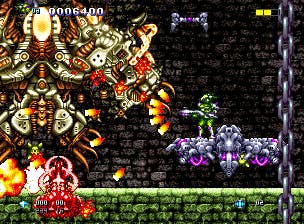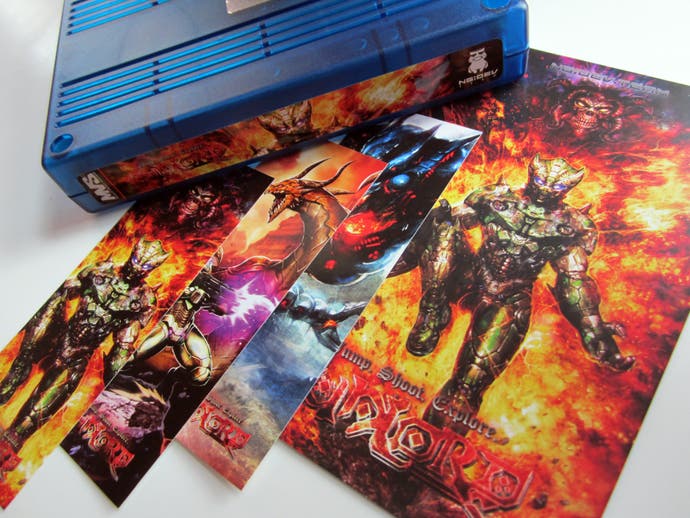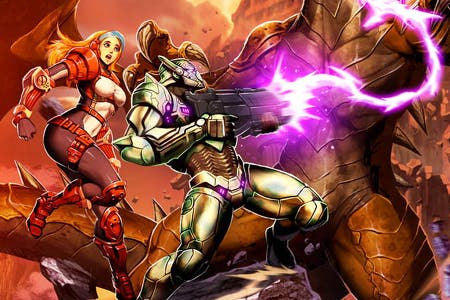Never Neglect the Niche: NG Dev Team on developing for dead systems
Germany's indie darlings speak exclusively about their new Neo Geo game, Gunlord
Collectors of the legendary SNK Neo Geo system must secretly smile to themselves when they hear modern console manufacturers waxing lyrical about grandiose 10-year hardware cycles; their beloved platform is now over two decades old and continues to enjoy software support - albeit in a somewhat limited capacity. Amazingly, NG Dev Team's Gunlord is a professional-quality Neo Geo cartridge released in the year 2012 - something that nobody could have predicted way back in 1990, when SNK launched its bold (and incredibly expensive) console/arcade hybrid. Few vintage systems can boast such astonishing staying power.
Germany's NG Dev Team isn't a stranger to SNK's hardware, and this isn't the first time they've developed for the seemingly dead platform. "We initially started in 2000 as a 'Doujin' developer - we were just two guys, my little brother René and me," explains Timm Hellwig. "We were fans of 16-bit games and wanted to create our own. As I was a huge Neo Geo fan and collector, my dream was to develop for that system. After a few months of reverse engineering and experiments, a prototype was made which later became Last Hope, our debut game."
Only 60 copies of Last Hope were manufactured for the domestic Neo Geo AES system when it launched in 2006, with Dreamcast and Neo Geo CD versions following in larger quantities later. More of a vanity project than a serious commercial endeavour, the critical reaction stunned the team. "We didn't expect to have much success with it," admits Hellwig. "But it surprised us. We decided that we wanted to develop games for a living, and founded NG Dev Team as an official company and created our second title, Fast Striker."

Gunlord as a concept actually pre-dates NG Dev Team's other projects, and in many ways can be viewed as the company's magnum opus. "Development started in 2003, but was paused for a few years so we could work on our other projects," says Hellwig. "In 2010 we reactivated the game and completed it this year. Overall, it probably had a development time of around 18 months, and over this period of time seven people worked on it. In the last six months of development we had around four graphic artists involved. Compared to our other titles, it's our biggest game so far."
"A Neo Geo cartridge is about 10 to 20 times as complex as a Megadrive or SNES cart; the shells were manufactured in China and the two huge PCBs that are in each cartridge were designed and produced in Germany. But as a result we have a very powerful and modern production system that can automatically program the cartridges."
A 2D run-and-gun action title in the mould of Manfred Trenz's C64 classic Turrican, Gunlord harks back to the tough-as-nails ethos held by many European game designers during the 16-bit era. Its varied environments are crawling with hand-drawn enemies and a particularly explosive death lies in wait around every corner. In short, it's not a game that willingly caters for casual players. "Gunlord takes inspiration from our favourite platforming games from the 16-bit era," says Hellwig. "Games like Turrican, but also Metroid and Contra." There's some surprising variety on display, too; when you're not dashing commando-style around the multi-directional levels, you take to the skies in missions which shift the gameplay to that of a side-scrolling shmup which would make Japanese shmup codehouse Cave proud, complete with screen-filling bosses and oodles of projectiles.
Like Last Hope and Fast Striker before it, Gunlord will also see release on the Sega Dreamcast - a machine which may not be as old and dusty as the Neo Geo, but is just as dormant in the eyes of its original manufacturer. This GD-ROM edition will take advantage of lower production costs and will retail at a more reasonable price than the cartridge release, but it will also harness the additional grunt of Sega's more adept hardware. "The improvements in the Dreamcast port are of a more technical nature," Hellwig says. "It will boast better music quality and eight times as many active sound effects. Due to the higher CPU performance the amount of special effects - like smoke and debris - will be increased."
While it's clear that Hellwig and his team are getting an incredible amount of personal satisfaction out of creating old-school titles for defunct systems, one has to wonder just how profitable such a venture can be - especially as the industry continues its inexorable shift from expensive physical media to cheap digital distribution. "The development and production costs were huge for the cartridges," admits Hellwig.

"An initial five-figure investment was necessary; the entire profit from sales of Fast Striker were ploughed into Gunlord. A Neo Geo cartridge is about 10 to 20 times as complex as a Megadrive or SNES cart; the shells were manufactured in China and the two huge PCBs that are in each cartridge were designed and produced in Germany. But as a result we have a very powerful and modern production system that can automatically program the cartridges. It's even possible for customers to update our games with a PC via a USB connection. In the end, we feel it was a good investment."
Hellwig is also adamant that catering for a niche audience - even one as painfully limited as the Neo Geo Collector's Club - makes financial sense, despite the attractive nature of the alternatives. "Everything is calculated and planned for this narrow niche; there is certainly not much room for error. But so far we are happy. AES and MVS cartridges combined make for a decent business. While the cartridge market grows, the Dreamcast market shrinks, but we will adapt to these changes and migrate to new platforms for ports if necessary."

"Low-resolution 16-bit-style games are not popular on those platforms unless they have the 'hipster' feel, and we're not interested in that. Our philosophy is to create modernized old school games and to evolve them slowly."
Ironically, in an era when small, independent developers are singing the praises of iOS and the App Store, Hellwig is less enthusiastic. "We already tried the iOS market with an iPhone version of Fast Striker, but our games are too niche for such huge marketplaces. We would need to make different games to appeal to iOS gamers, but we don't have much interest in this overcrowded market."
He also struggles to find nice things to say about Xbox Live Arcade and the PlayStation Network. "Low-resolution 16-bit-style games are not popular on those platforms unless they have the 'hipster' feel, and we're not interested in that. Our philosophy is to create modernized old school games and to evolve them slowly." Taking this into account, is the team interested in any of the current crop of systems? "Currently the 3DS is the most interesting mainstream platform for us," Hellwig replies. "People on that platform seem to like 2D titles, and Nintendo is supportive about publishing such games."
So with the accepted avenues for indie developers seemingly off-limits for NG Dev Team, where does the company's future truly lie? Not too far away from where it currently resides, it would appear. "Certainly we will continue to develop for Neo Geo MVS and AES; we are currently working on two new games for it," explains Hellwig. "An old-school overhead game like Ikari Warriors, and a shooting game. But we will also expand into the modern HD platforms like Steam, and possibly even consoles too; our first HD title is planned for 2013. We are also increasing our hardware development efforts; this year we will have a completely new line of products ready that will open an additional niche market for us."
There's that word again: niche. While the vast majority of game developers do their utmost to avoid being trapped in a small sector of the market, NG Dev Team positively revels in it - and more importantly, it has proven that it's a viable path, too.

